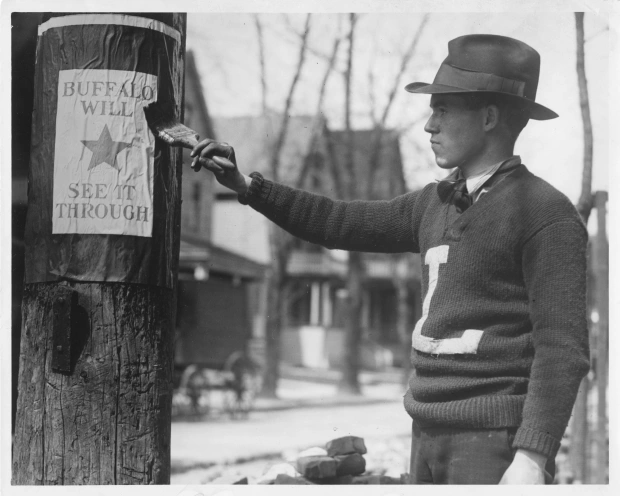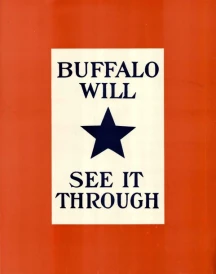 Part of the process of preparing for a major exhibit is to get familiar with the relevant material items in our collection. One of the things we did in the Library is to compile a bibliography, called Buffalo in World War I, which gives the researcher a good idea of what we have before planning a visit.
Part of the process of preparing for a major exhibit is to get familiar with the relevant material items in our collection. One of the things we did in the Library is to compile a bibliography, called Buffalo in World War I, which gives the researcher a good idea of what we have before planning a visit.
We thought we’d feature a few World War I pieces in this newsletter.
In 1918 and 1919, the U.S. Government hosted a series of War Expositions around the country. The show came to the Broadway Auditorium and Elmwood Music Hall from January 4 to 12, 1919. Some of the featured exhibits were American war trophies; weapons and other goods from the U.S Army & Navy; a British government collection of war relics; a British collection of German contraband found in the mails; military training material about “social hygiene” (sexually transmitted infections), and live demonstrations of Boy Scout skills. The Library has the souvenir catalogue from the Exposition.
Fort Porter Reporter, January 31-September 29, 1919
Long demolished to make way for the Peace Bridge, Fort Porter was an active Army base during World War I. This newspaper succeeded Trench and Camp as the fort’s weekly soldier paper. It reported on such activities as the construction of a new garage; the arrival of male nurses; the value of the X-ray; the anticipation of a jazz dance at the Elmwood Music Hall; the meaning of insignia on uniforms; the proper disposition of enemy goods captured during battle; and notices of casualties, weddings, and promotions. Our issues are in hard copy in a single bound volume.
It is a short publication with a long name. This foldout brochure was compiled by the Buffalo Commission on War Camp Community Service in 1918. The first order of business was to alert members of the armed forces where they could find inexpensive lodgings in Buffalo. In 1918, there were three Service Clubs operating, all in or near downtown Buffalo. These were destinations designed for visiting soldiers, featuring such amenities as meals, baths, “writing rooms,” reading rooms, and entertainment. Servicemen were also informed about libraries, military offices, railroad stations, hospitals, major churches, and entertainment. During the war, seats at the Buffalo Baseball Park, later the site of Offermann Stadium, were free to men in uniform.
Duffy’s War: Fr. Francis Duffy, Wild Bill Donovan, and the Irish Fighting 69th in World War I
Published in 2008 by Stephen Harris, this book is one of our more recent acquisitions. The 69th Infantry Regiment is presently headquartered in Manhattan. During World War I, one of its members was a Buffalo soldier, William J. Donovan, who later went on to found the Office of Strategic Services, known today as the CIA. When he joined this unit, Donovan was a 34-year-old attorney. At the end of the war, he was a colonel. Francis P. Duffy, a military chaplain, was revered by his troops and earned more decorations than any other clergyman in U.S. Army history. Duffy Square in New York City is named in his honor.
This slogan was coined to support the Liberty Loan drives. It was produced and distributed as a poster and handbill. In a previous newsletter, we published a photograph of a young man pasting it to a telephone pole. In the Library’s vertical files are examples of the original poster in its original red, white, and blue. You may order your own copy by clicking on the poster.
Cynthia Van Ness, MLS
Director of Library & Archives
*This article was featured in the Spring 2017 issue of The Album, The Buffalo History Museum’s quarterly newsletter.
